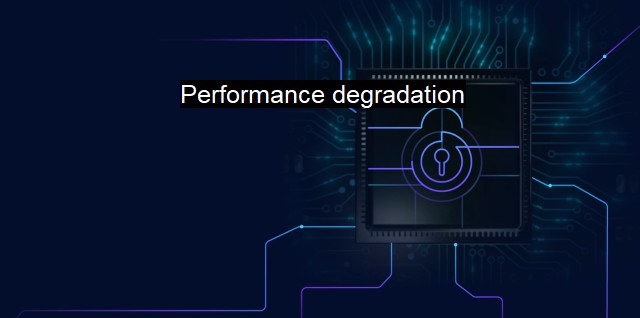What is Performance degradation?
Performance Degradation: The Dilemma of Antivirus Software in Cybersecurity for Small- and Medium-sized Businesses"
Performance degradation is a concept typically referenced in many domains, including cybersecurity and antivirus software. In its simplest form, in general computing context, it refers to a gradual decline in the operating performance of a system. in the cybersecurity and antivirus sphere, the term takes on added connotations and specific complexities.Fundamentally, performance degradation in cybersecurity refers to the slowing down of a system's performance due to factors such as malware infections, excessive utilization of resources by antivirus programs, or the activities of complex cyber threats that can effectively hamper system performances. Understanding this phenomenon requires a proper understanding of malware and other forms of cyber threats.
Malware, short for malicious software, refers to various forms of harmful software, such as viruses, trojans, worms, ransomware, and spyware. Malware is often used to disrupt computer operations, gather sensitive information, gain unauthorized access to computer systems, and in some cases, to display unwanted advertising content.
The antagonism between malware and antivirus software is at the heart of performance degradation in the context of cybersecurity systems. When a system infected with malware runs antivirus software to detect and eliminate the malware, this may result in overconsumption of system resources, such as CPU and memory. This often results in a slowdown in system operations, which effectively is performance degradation. Heavy antivirus software can act like valid software but consume excessive system resources, thereby affecting system performance negatively.
Another critical issue associated with performance degradation is the phenomenon of false positive detection by some antivirus software. A false positive occurs when an antivirus software mistakenly flags a legitimate, non-malicious file or program as malware, thereby unnecessarily consuming system resources for their remediation or quarantine.
Cyber threats are continually evolving in their sophistication, leading to more advanced and complex forms of attacks, like Advanced Persistent Threats (APTs). These threats are often lodged deep within a system and remain undetected for long periods while continuing their malicious activities. Such cyber threats can cause significant performance degradation.
In terms of sheer volume and frequency of attacks, Denial-of-Service (DoS) and Distributed Denial-of-Service (DDoS) attacks also significantly contribute to performance degradation. These attacks flood systems or networks with traffic to the point they are no longer able to function properly or at all. In the process, they cause substantial performance degradation and impact productivity negatively.
Another important aspect to note is how older systems are particularly susceptible to performance degradation. These systems usually have limited resources and often can't cope with newer, resource-intensive software. Also, they may lack adequate security patches, making them prime targets for cyber attackers.
Effective cybersecurity strategies include regular system updates, use of lightweight but robust antivirus software, implementing a robust firewalls system, encouraging safe internet practices among users, and regularly reviewing and auditing system performances to spot and address any signs of performance degradation promptly.
Performance degradation in the context of cybersecurity is a genuine solitary battle between maintaining optimum system performance and ensuring maximum system and data protection. Comprehensive cybersecurity measures and mitigation strategies are thus essential to maintain a balance, to assure not just the safety of essential information and continuity of operations, but also integrity of the overall user experience.
Therefore, striking an optimal balance between antivirus software use, prevention of malware attacks, and assurance of high system performance rates, is very important. This further assures sustained system resource availability, which constitutes a critical part of cybersecurity best practices, and helps to significantly mitigate the adverse effects of performance degradation.

Performance degradation FAQs
What is performance degradation in cybersecurity?
Performance degradation in cybersecurity refers to a decrease in the speed and efficiency of a computer system, software or application due to the installation or operation of a security program like antivirus.What causes performance degradation in antivirus?
Performance degradation in antivirus is caused by several factors such as a large number of files being scanned, frequent updates and scans, inadequate system resources (CPU, RAM), and conflicts with other programs running on the machine.How can I improve performance while using antivirus?
To improve performance while using antivirus, you can try reducing the scanning frequency, restricting scans to specific folders, configuring the antivirus to exclude certain files/folders, and ensuring that your system has adequate hardware resources. You can also consider upgrading to a lighter antivirus program that uses less system resources.Is performance degradation a tradeoff for cybersecurity?
Performance degradation is often considered a necessary tradeoff for maintaining cybersecurity. However, with the advancement in technology, many antivirus programs are designed to minimize the impact on system performance while still providing robust protection against cyber threats. It's crucial to find a balance between cybersecurity and system performance to ensure that your system remains secure and efficient.| | A | | | B | | | C | | | D | | | E | | | F | | | G | | | H | | | I | | | J | | | K | | | L | | | M | |
| | N | | | O | | | P | | | Q | | | R | | | S | | | T | | | U | | | V | | | W | | | X | | | Y | | | Z | |
| | 1 | | | 2 | | | 3 | | | 4 | | | 7 | | | 8 | | |||||||